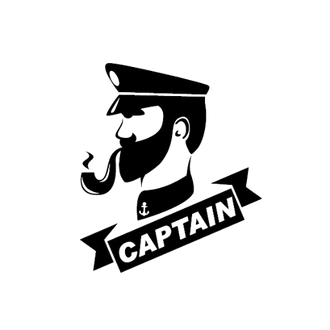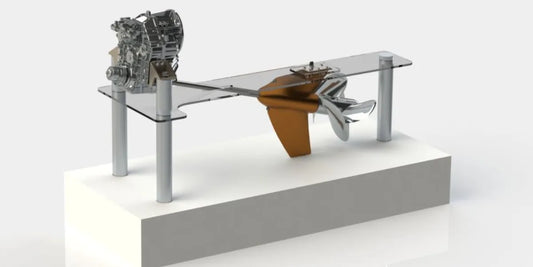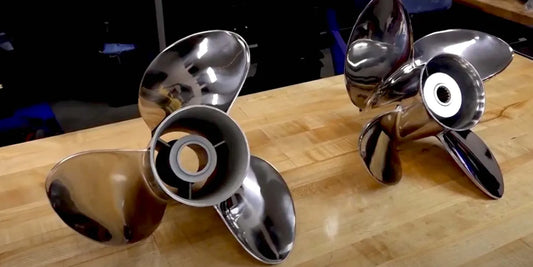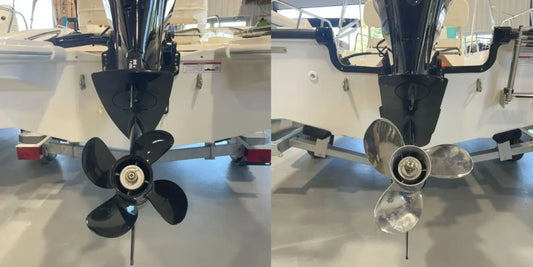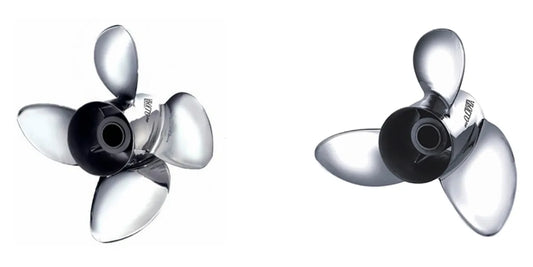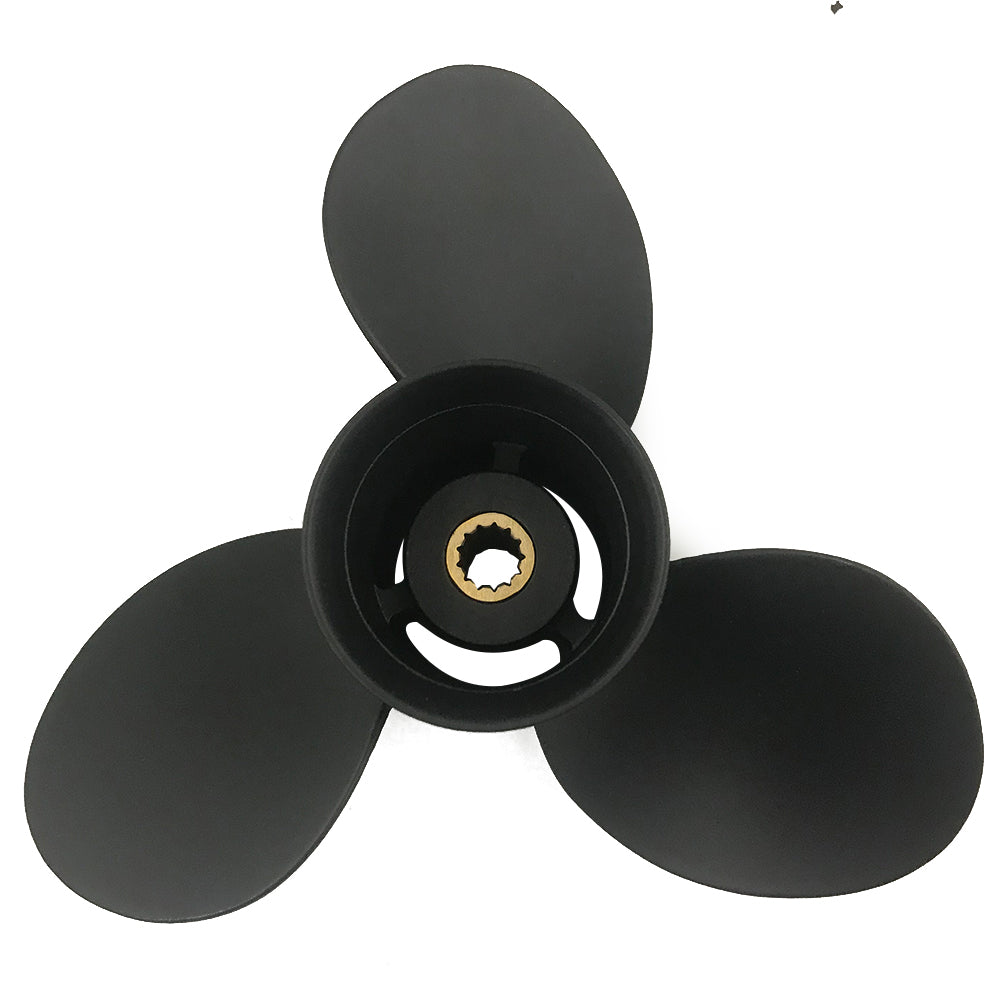This article will help you embrace your boat's true potential. From a Yamaha weekend cruiser, an avid fisherman to a water sports enthusiast, this article will set you in the correct direction. This guide is intended for anyone who wishes to maximize the efficiency of the vessels they operate. To get the most from their boat, they have to know what best suits it and, as a result, make the best blend of speed, fuel efficiency, and overall finesse handling of the boat. Choosing the perfect Yamaha propeller will help you achieve all that. This guide is aimed at helping boat owners increase the speed and handling of their boats. However, each propeller suits a particular ship and activity; thus, considerations like engine type, boat size, and propeller use are essential.
What factors should I consider when selecting a Yamaha propeller for my boat?

How do boat size and type affect propeller choice?
Handling and performance are significantly impacted by the type and size of the boat, thus becoming a direct consideration when choosing a Yamaha propeller. Propeller performance is usually optimal with the larger diameter and lower pitch of thrusting, heavier, and larger boats. On the other hand, lighter and smaller boats rely on the higher pitch and smaller diameter propellers to improve speed and further acceleration.
Diameter: Larger boats are expected to be less responsive, so a larger diameter is required. Faster-responding lighter vessels require better handling, so a smaller diameter is desired.
Pitch: Heavier and slower boats prefer low-pitch for better torque, while smaller and faster boats prefer high-pitch propellers.
Blade Count: Stability and load-bearing capacity are proficient in propellers with more blades for heavier boats, while fewer blades enhance speed by lowering drag in smaller and sportier vessels.
Material: Stainless steel propellers perform better under higher stress for more powerful boats, while aluminum propellers are more affordable for more minor, leisurely boats.
Consideration of the size, weight, and proposed use of the boat allows one to appreciate the versatility of Yamaha propellers in meeting the value performance design and power requirements one desires.
What role does engine horsepower play in propeller selection?
The weight of the engine horsepower is heavily felt when choosing a propeller, and its importance cannot be stressed enough since it dramatically affects the appropriate pitch and size of the propeller. A pitched propeller to match the engine's horsepower ensures that power is transferred efficiently and that the engine is not stressed.
Pitch: A propeller with a higher pitch is designed for use with a higher horsepower engine. It increases speed, but the engine has to work harder than before. On the other hand, a lower horsepower engine must be pitched lower to provide more effortless acceleration without causing too much strain.
Diameter: Larger diameter propellers may be required by higher horsepower engines to make good use of the larger power output. In contrast, lower horsepower engines perform much better with smaller-diameter propellers because they can provide smoother performance.
RPM Range: The specific propeller should be able to achieve the limit of the wide-open throttle (WOT) RPM range. If this limit is exceeded or not fully reached, underperformance or long-term engine complications are bound to occur.
Ignoring some of all these factors results in propellers that operate at low power settings, which puts them at risk of increasing fuel consumption without improving performance.
How do different boating activities influence propeller options?
The type and size of a boat directly affect its handling and performance, which is critical when considering a Yamaha propeller. It’s usually easier to thrust the larger and heavier boats, and they have optimal propeller performance with lower pitch and larger diameter propellers. On the contrary, lighter and smaller boats require higher pitch, lower diameter propellers for increased speed and further acceleration.
Diameter: With lower responsiveness, larger boats require larger propeller diameters. In contrast, lighter vessels respond faster, requiring smaller props for better handling.
Pitch: Heavier and slower boats usually prefer low-pitch blades, which are more efficient in delivering torque, than smaller, faster boats, which prefer high-pitch propellers.
Blade Count: Propellers with more excellent blades exhibit proficient stability and load-bearing capacity, making them suitable for heavier boats, while sporty and smaller vessels are less dragged during the cruise, causing fewer blades to enhance speed.
Material: Propellers with stainless steel claim superior performance under higher stress, benefiting the more powerful boats, while cheaper aluminum propellers benefit leisurely smaller boats.
Considering the boat's weight, size, and proposed use, Yamaha propellers are ideal for achieving the desired performance, design, and power.
What are the differences between 3-blade and 4-blade Yamaha propellers?

How do 3-blade propellers affect boat performance?
Due to their well-balanced performance parameters, 3-blade propellers are among the most popular options. They offer superior high-speed performance, greatly benefiting activities like water sports or cruising. A 3-blade propeller has a smaller surface area when compared to higher blade count propellers, meaning less drag and better fuel efficiency, leading to acceleration.
Speed: Higher top speeds when compared to a 4-blade propeller as less drag is experienced.
Efficiency: Better fuel efficiency during most scenarios because of lower propeller blade count.
Acceleration: Enhanced acceleration because rotational resistance is lower and is better suited for lighter loads or speed-centric use.
Diameter and Pitch: These parameters are usually set to a level that balances thrust and speed and ensures performance stability in various scenarios.
However, under heavy loads or during rough conditions, 3-blade propellers might not offer the same amount of thrust and stability as needed, making them less ideal for situations requiring higher control and torque.
What advantages do 4-blade propellers offer?
As opposed to 3-blade propellers, 4-blade propellers do have significant advantages. One of them is efficient performance for heavy-duty tasks or under challenging conditions. The benefits of a 4-blade propeller design are outlined below:
Enhanced Stability and Thrust: An extra blade means better and smoother operation, with more thrust under heavy loads and control, improving reliability.
Stronger Propulsion in Rough Waters: More blades on a propeller means more grip on the water, reducing ventilation and improving efficiency, especially during sharp turns.
Increased Power Inconsistency At Low Speed: 4-blade propellers are best suited for towing as they provide precise control and consistent low-speed power. These attributes also help during precise maneuvering, like fishing.
Quieter Operation: Sustained comfort is achieved as dual blade vibrations are more silent, enabling a more comfortable and relaxed experience using the boost feature.
Optimized Diameter and Pitch: Instead of standard diameter and pitch propellers, these have smaller ones that balance power and rotational resistance, leading to better comfort and stability.
Overall, 4-blade propellers are ideal for applications requiring lower speed control and maximum grip and stability despite the loss of top-end speed compared to 3-blade propellers.
Which blade configuration is best for fuel efficiency?
Regarding fuel efficiency, 3-blade propellers are the best choice as they minimize drag while thrust power is sufficient for most applications. There are a few reasons why the above statement may be true. Let’s discuss them here:
Reduced Drag: The 3-blade propellers require less energy to maintain propulsion, which is achieved due to the blades' low surface area and drag.
Higher Top-End Speed: 3-blade combinations are known to outperform 4-blade configuration propellers by providing greater fuel efficiency when cruising.
Engine Load: Propellers with three blades rotate with lower resistance; this allows them to be paired with more powerful engines, and therefore, more fuel can be saved.
Generally, a 3-blade propeller will yield positive results for vessels looking to save fuel, which is subject to changes in individual performance within the parts of vessels, operating conditions, and engine pairings.
How do I choose between stainless steel and aluminum Yamaha propellers?

What are the benefits of stainless steel propellers?
Stainless steel boat propellers have become the choice for many boaters due to their numerous advantages, as highlighted below:
Durability: Unlike aluminum, stainless steel is far more impact-resistant and vigorous, making it durable. Because of its toughness, stainless steel has a longer life span in harsh marine surroundings.
Performance: Stainless steel offers better fuel efficiency and consistent results when operating at higher speeds. This is mainly because they are rigid, maintaining blade shape under heavy loads.
Enhanced Efficiency: Precise casting processes enable improved design intricacy that aids speed and hydrodynamic flow cavitation, enabling more advanced blade structures.
Corrosion Resistance: Stainless steel is less prone to degeneration than many other materials, making it sound even when used in salty water. Thus, it is reliable over the long term.
Although stainless steel propellers are more costly than aluminum-based alternatives, the exceptional performance and extended life cycles accompanying high-performance vessels or those heavily used justify the cost readily.
When should I opt for aluminum propellers?
The best option for boat owners who want something easy to maintain and economical is aluminum propellers. They tend to be much cheaper than their stainless steel counterparts, whcih makes them perfect for leisure boats or vessels that don't face very harsh conditions. Besides being lightweight, aluminum propellers are easier to repair, which can help save money on maintenance.
Aluminum propellers are far cheaper than their stainless steel counterparts, ranging from 2 to 3 times less expensive. Thus, they are easily accessible to any price-sensitive user.
It is best limited to freshwater or places with less abrasion, as aluminum does not hold well in rough conditions.
Aluminum propellers are best for low-powered (<150 HP) boats that do not require a lot of speed and performance.
Aluminum is best suited for recreational or occasional use when damage is likely, as it can be easily replaced or repaired.
Aluminum provides all the above benefits but fails to deliver the durability and efficiency required for high-power or heavy-use vessels.
How does material choice impact propeller durability and performance?
Choosing the right materials for various components is crucial for their durability and performance. Each material has its advantages and setbacks:
Aluminum Propellers are light and inexpensive, making them great for barefoot and lightweight power boating. However, their softness makes them easy to damage through common impacts, and their durability is significantly lowered in harsher conditions.
Stainless Steel Propellers: Their strength and resistance to impact deformation are the best benefits. These propellers are considerably more corrosion-resistant and cost more because they are needed for high-performance and heavy-duty applications.
Composite Propellers: These are favored in cases where there is a need to balance performance and cost. They have decent corrosion resistance and provide low weight while being reliable in terms of durability.
The choice of boating application with engine power always depends on the desired compromise between cost, performance, longevity, or type.
What Yamaha propeller options are available for specific boating activities?

Which propellers are best for trolling and fishing?
Yamaha recommends lower-speed propellers optimized for precision and control for trolling and fishing. These options are the best suited:
Yamaha Talon SS4 Propeller: Proprietary design that excels with low-speed trolling due to excellent durability and maneuverability. A 4-blade prop design is used to increase control and minimize vibrations. This design helps significantly with maintaining a steady speed while fishing.
Yamaha Dual Thrust Propellers: These propellers are intentionally designed to work great with trolling motors. Their thrust control at slow speeds is exceptionally high. They are also specially designed to push water towards themselves, greatly enhancing the boat's fishing control.
When considering which propeller to use for trolling or fishing, the following options should be closely evaluated:
Blade Count: A high blade count is ideal for effective grinding during trolling as it improves control.
Pitch: A lower pitch width (for example, between 9 and 13 inches) greatly enhances working at lower speeds, increasing accuracy.
Material: The recommended stainless steel composite is favored due to its increased strength, especially in rough weather, but other options can work if budget-friendly materials are needed.
To sum up, selecting a propeller should seamlessly complement the needs of your fishing environment and the engine.
What propeller features enhance cruising performance?
To improve cruising ability, the following propeller characteristics should be analyzed.
Blade Count: Three-blade propellers are ideal for cruising as they offer speed and efficiency ratio in drag reduction and a good performance system.
Pitch: During cruising, a higher pitch, enabling faster and optimal fuel efficiency (17-23 inches) is better, as the engine cover the distance on one rotation.
Diameter: The thrusts of larger propellers with higher diameters increase, which is useful when the propeller's cruise speed is maintained against the state of water.
Material: Cruising generally prefers stainless steel, which performs better under load and faster while providing good, productive, and durable performance.
Cupping: Edge cupping helps improve speed efficiency, reduce slippage, and improve performance while cruising in open, smooth water.
When operating at cruise performance, these factors should correspond to the engine`s power output and the vessel`s load conditions when the optimized cruise performance is needed.
How do I choose a propeller for wakeboarding or water sports?
When picking a propeller for wakeboarding or any other water-based sport, my main focus revolves around acceleration and pulling power. Subsequently, here are some of the factors that need my attention:
Pitch: Regarding pitch, I choose a lower value as it enhances torque and enables quicker acceleration while pulling the wakeboarders out of the water.
Diameter: Propellers with slightly larger diameters offer improved thrust at lower speeds, which is useful for towing.
Blade Count: Four—or five-blade propellers assure smoother operations and better control, which is exceptional when sharper turns are involved, or vigorous speeds are required during the tow.
Material: While aluminum propellers are often enough, stainless steel propellers are far more enduring and, thus, better for intense water sports.
The employment of these parameters with the boat engine power and the expected load guarantees the best performance for water sports while ensuring ease of water control.
How can I ensure optimal performance and longevity of my Yamaha propeller?

What maintenance practices should I follow for my Yamaha propeller?
So that my Yamaha propeller runs smoothly and lasts as long as possible, I like to stay on top of propeller maintenance. Here is the routine I follow:
Inspect for Damage: I habitually check the propeller for dents, cracks, and bends. If left unattended, these minor imperfections can impede propeller thrust and balance, reducing speed and fuel economy.
Clean Regularly: I also make it a point to scrub the propeller free of marine growth, debris, and corrosion. This keeps the propeller working as it should while preventing unnecessary thrust and RPM drag.
Tighten and Secure: I eyeball the propeller nut and cotter pin to confirm they are fastened. If left unresolved, these fittings can lead to propeller delamination or uneven operation.
Grease The Shaft: Coating the propeller shaft with marine-grade grease prevents corrosion and makes maintenance more manageable, especially in saltwater.
Monitor For Vibration: I observe the propeller for anything resembling excessive vibration. If this is noticed, I start looking for unbalanced blades as the likely culprit. These tend to cause undue stress on the engine and lower unit.
Implementing these practices will bring me closer to ensuring the propeller's structural integrity stays intact while allowing smooth operation, durability, and reliable connection to the boat's engine power.
Every move coincides with the technical requirements for actions like thrust, RPM, and control, so the engine and propeller function optimally.
How often should I inspect and replace my boat's propeller?
I examine my boat's propeller at least once a month or before each use, depending on how often I use the boat and the local weather conditions. Regular checks make it easier for me to detect damage, corrosion, or buildup, which may impede the propeller's functioning. If there is considerable wear and tear, deformation of blades, or cracks on the propeller, which can affect its working, then I have to replace it. These steps make sure that optimal technical parameters are maintained, which include:
Thrust Efficiency: A damaged propeller will reduce thrust from the boat, which makes it harder for the damaged propeller to aid the boat's movement.
RPM Consistency: Blades that are out of balance or too worn may change the engine's RPM, resulting in low performance or an engine overload.
Vibration Control: Maintenance of the propeller leads to fewer violent shakes, further lessening the engine and lower unit strain.
Fuel Economy: The smoother a propeller works, the lower the boat's fuel consumption.
Considering these factors lets me ensure that my boat operates under the best conditions on the water.
What signs indicate that it's time to upgrade or replace my propeller?
Here is when you should think about propeller upgrades or replacements:
Unusual Reduced Thrust Efficiency: If the boat is having a tough time trying to keep up speed or accelerate, the propeller is most likely worn or damaged, leading to inadequate thrust performance.
Unusual Irregular RPM: A sudden change in the engine's RPM, like going above the limit or performing below or setting the throttle, can derive from an inefficient or unbalanced propeller.
Excessive Vibration: Continuous and unyielding vibration during operation usually points toward a bent or cracked blade, which can strain the engine and other components.
Lower Fuel Economy: An uncontrollable increase in fuel usage can be attributed to a low-performing and inefficient propeller.
Physical Damage or Wear: Visible cracks and blade erosion are excellent indicators of compromised propeller structure.
Addressing the signs as soon as you notice them will help maintain a boat's peak operational performance and fuel efficiency.
Frequently Asked Questions (FAQs)
Q: What considerations should I remember when selecting the perfect propeller to use with my Yamaha outboard?
A: The type of boat you own, the horsepower of the engine, the performance objectives you want to achieve (such as fuel efficiency, top speed, or acceleration), and the typical condition of the water are some factors to consider when choosing the most suitable propeller for your Yamaha outboard. The material (stainless steel or aluminum) a propeller is made of, along with its blade quantity and pitch, also needs to be considered.
Q: What are the benefits of having a three-blade propeller for Yamaha outboards?
A: One of the most remarkable advantages of fitting three-blade propellers on Yamaha outboards is their fantastic overall performance. It achieves a healthy mix of fuel economy, top speed, and acceleration. They are frequently preferred for relatively light boats, and the engines work smoothly when turning at many RPMs. Additionally, they are known to be cheaper than the four-blade style.
Q: What is the difference between a four-blade and three-blade propeller for Yamaha engines?
A: Compared to three-blade props, four-blade propellers frequently deliver better throttle response, enhanced control, and a more pleasant and peaceful ride. They usually perform better at low RPMs, useful during cruising or in spotting fish. Four-blade propellers are popular for heavy boats and boats using high horsepower outboards like Yamaha F200 or 300 hp outboards.
Q: Explain the Yamaha SDS (Shift Dampener System propeller) Designs and their advantages.
A: The Yamaha SDS design is a propeller, and no additional special hardware is necessary for it to work. It assists in lowering shift clunk and prop vibration, making shifting and trolling quieter. This design improves passenger comfort and enhances the boating experience, especially for inline four-cylinder outboards, because the overall ride becomes more peaceful and smoother.
Q: Which Yamaha propeller series is best for medium and small boats using T50-F115 outboards?
A: The Yamaha K series propellers are the best option for mid-sized to small vessels using the T50-F115 Yamaha outboard. These propellers have great utility in many applications, such as pontoons and flatsboats, which are smaller in weight. K series boats in this power band have good acceleration, top speed, fuel economy, and overall performance.
Q: How can I determine the correct propeller pitch for my Yamaha outboard?
A: Yamaha recommends using propeller pitches with your outboard’s propeller, enabling the engine to operate within its suggested RPM range while at wide-open throttle (WOT). If your engine isn’t reaching the RPM, you’ll probably need a prop with a lower pitch; if you are exceeding the range, a higher pitch would be ideal. Contact a Yamaha dealer or a marine technician for a recommendation that would work well for your boat and outboard performance expectations.
Q: What are the key advantages of using stainless steel propellers designed for Yamaha outboards?
A: Generally, stainless steel propellers for Yamaha outboards have more benefits than their aluminum counterparts. They are more resistant to being bent, providing better performance and longer life. Parts made of stainless steel can have thinner blades for more efficient propeller designs. Stainless steel props are also less likely to deform under heavy loads. Their performance also becomes more consistent over time. Though they are more costly, stainless-steel propellers are the best choice for high-performance uses or for boats operated in rough conditions routinely.
Q: What is the best way to research Yamaha's propeller selection for my boat?
A: Go to Yamaha's official page and use their propeller selection feature for propeller searches. Enter your boat and engine specifications, then wait for the recommendations. You may also visit authorized Yamaha dealers who are familiar with your particular requirements and can offer sound advice on the conditions in your area. Be open to changing propellers to gauge which one delivers the best balance for your speed, riding, and other boating activities you enjoy.
